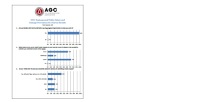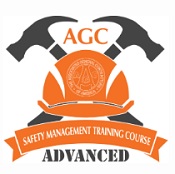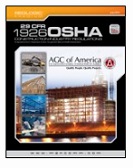 |
||||||||||||||||||||||
| Archive | Subscribe | Safety and Health | Constructor Buyers' Guide | ||||||||||||||||||||||
|
Top News
January 12 – 14, 2022 | Renaissance Phoenix Glendale Hotel & Spa, Glendale, AZ
Register today for AGC’s Construction Safety & Health Conference, the industry’s foremost annual conference to hone in on the most critical safety and health compliance and risk issues impacting the business of construction. If your goal is protecting the safety and health of the men and women working in construction, this is the conference for you. The conference provides educational options for attendees through a mixture of plenary and breakout sessions which cover issues in three broad categories:
• Managing safety & health requirements and risk
• Factoring safety & health concerns into phases of a project • Expanding your knowledge and skills
The AGC Construction Safety Excellence Awards (CSEA), sponsored by Willis Towers Watson, is the industry’s elite safety excellence awards program. The CSEA recognizes companies that have developed and implemented premier safety and risk control programs and showcases companies that have achieved continuous improvement and maintenance of their safety and health management systems. For more information on the CSEA program, please click HERE. The deadline for submitting applications is Wednesday, December 15, 2021.
AGC Releases New Series of COVID-19 Vaccine PSAs to Encourage Construction Workers to Get their Shot
AGC of America is releasing a new series of COVID-19 vaccine PSAs designed to encourage construction professionals to get their shot. The series will feature testimonials from workers who did not get their shot, contracted COVID and nearly died. They are now urging their co-workers to get their shots. Other videos feature construction mentors talking about the value of the vaccine. You can view the current videos here. The videos urge people to visit AGC of America’s vaccine toolkit to learn more. The videos are designed to be used by any construction firm, to be shown to construction workers. For more information, contact Brian Turmail at brian.turmail@agc.org or 703-459-0238.
There are significant flaws with the current 811 utility location system according to a new survey of construction firms that perform any kind of underground excavation released by AGC of America recently. Most contractors say that calling 811 often leads to inaccurate line marking and that utility firms are often very slow in coming out to even do locate and mark their underground lines. “Construction firms are doing their part to avoid hitting utility lines, but the current 811 system appears to be badly flawed,” says Stephen E. Sandherr, the association’s chief executive officer. “Fixing the 811 system will go a long way in protecting the safety of construction crews and the communities near these utility lines.” Read more and view the survey results HERE.
Help us generate a comprehensive outlook for 2022 by taking the survey today
Each year around this time, AGC asks you – our members – to predict what next year will be like for your business. AGC has partnered with Sage to prepare questions that focus on expectations for market performance, hiring, labor market conditions, etc. Please take a moment to complete the survey HERE. AGC of America will use the survey results to help make the case with elected and appointed officials in support of key member priorities. The more people who complete the survey, the more effective the results will be in supporting our work on your behalf. Regulatory & Legislative Updates
The U.S. Department of Labor’s Occupational Safety and Health Administration has extended the comment period for the COVID-19 vaccination and testing emergency temporary standard to Jan. 19, 2022. OSHA extended the comment period by 45 days to allow stakeholders additional time to review the ETS and collect information and data necessary for comment.
On November 15, AGC, along with industry allies, filed a lawsuit in the U.S. Court of Appeals for the Fourth Circuit challenging the recent OSHA COVID-19 emergency temporary standard (ETS). The suit highlights the many efforts the construction industry has collectively engaged in to combat COVID-19, including funding public service announcements and other proactive measures to encourage contractors to protect their workers throughout the pandemic. It also makes clear that the challenge is not in opposition to the ETS’s objective to get more people vaccinated, but the negative economic impact such a mandate will have on the construction industry and the fact that it exceeds the statutory authority of the U.S. Department of Labor. In all, there were 34 cases filed in 12 different circuits. On November 16, the U.S. Court of Appeals for the Sixth Circuit was randomly selected to consolidate all the cases. If you have any questions, contact Kevin Cannon at kevin.cannon@agc.org or Nazia Shah at nazia.shah@agc.org.
Biden administration expected to challenge
In response to the U.S. Court of Appeals for the Fifth Circuit November 12 decision to temporarily halt (issue a stay on) the recent OSHA COVID-19 emergency temporary standard (ETS), OSHA announced on November 17 that it “has suspended activities related to the implementation and enforcement of the ETS pending future developments in the litigation.” However, OSHA also noted that it “remains confident in its authority to protect workers in emergencies” and is considered likely to challenge the current pause on its ETS implementation and enforcement before the U.S. Court of Appeals for the Sixth Circuit, where the 34 cases filed against the OSHA ETS—including AGC’s—have been consolidated. It is not clear as to what the outcome regarding the ETS will be. Pending the outcome of litigation, employers should continue to review the ETS and plan for actions they will take in the event the ETS is implemented. It is worthy to note that this current suspension of OSHA’s ETS does not change compliance requirements for those employers who are considered federal contractors covered separately by that vaccine mandate. The vaccination mandates for federal contractors are still in place and have not been impacted due to the court’s action in the OSHA ETS case. For more information, visit AGC’s COVID-19 Vaccine Toolkit.
Joins DOL & NLRB in interagency initiative to end retaliation
The U.S. Equal Employment Opportunity Commission (EEOC) updated its COVID-19 technical assistance to include more information about employer retaliation in pandemic-related employment situations. This updated technical assistance also supports the EEOC’s participation in an interagency initiative to end retaliation against workers who exercise their protected labor and employment law rights. The other participants in the initiative are the U.S. Department of Labor (DOL) and the National Labor Relations Board (NLRB). The initiative will include collaboration among these civil law enforcement agencies to protect workers on issues of unlawful retaliatory conduct, educate the public and engage with employers, business organizations, labor organizations and civil rights groups in the coming year. Provides additional information on religious objections to workplace vaccine requirements
The U.S. Equal Employment Opportunity Commission (EEOC) posted updated and expanded technical assistance related to the COVID-19 pandemic, addressing questions about religious objections to employer COVID-19 vaccine requirements and how they interact with federal equal employment opportunity (EEO) laws.
Events
December 6 – 8, 2021 | Cincinnati, OH
Standard Registration Rate: $1195 This unique three–day course provides construction safety and health professionals with the next–level knowledge required to successfully manage a company–wide safety program. Moving beyond the basics of Focus Four training, AGC’s Advanced Safety Management Training Program will give participants a more holistic view of safety’s role in project and company success, as well as advanced tactics and best practices for managing all aspects of a corporate safety program.
According to the Bureau of Labor Statistics (BLS), from 2015 to 2018, the Census of Fatal Occupational Injuries (CFOI) reported 103 total trenching and excavation-related deaths, an average of 25 per year over this 4-year period. Also, the OSHA Information System (OIS) Accident Investigation Report shows that between FY 2013 – FY 2017, there were a total of 156 incidents reported in the construction industry. Moreover, between October 2018 and September 2019, there were 1,499 citations and more than $7,000,000 in penalties issued to construction employers for failing to meet their compliance obligations under Subpart P.
AGC of America, supported by a Susan Harwood Federal Training Grant, is pleased to offer this one-day Trenching & Excavation Hazards in Construction safety training based on OSHA standards and best practices to answer the need for quality training within the industry. Classes will be delivered virtually via Zoom Meetings and attendees will have the opportunity to earn continuing education credits (0.8 IACET CEUs).
All classes will be held between 10 AM and 6 PM Eastern Time on the following dates:
• December 9
• December 10 • December 13 • December 14 Register Here. You will be emailed a Zoom Meeting link closer to the training date you select.
Safety Cabinet
This handy 29 CFR 1926 volume is made with RegLogic®, which takes the difficulty out of reading and using government regulations. You can use the book's Quick-Find Index™ to quickly access the information you need. Included you will find the 1903 regulations on inspections, citations, and proposed penalties; the 1904 regulations on recording and reporting occupational injuries and illnesses; pertinent 1910 general industry regulations; and every 1926 construction industry regulation. Updated through Jan. 2011.
|
||||||||||||||||||||||












